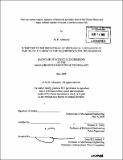Nervous system cancer : analysis of historical mortality rates in the United States and Japan indicate sudden increases in environmental risk
Author(s)
Alhassani, Ali K
DownloadFull printable version (7.234Mb)
Alternative title
Analysis of historical mortality rates in the United States and Japan indicate sudden increases in environmental risk
Other Contributors
Massachusetts Institute of Technology. Dept. of Mechanical Engineering.
Advisor
William G. Thilly.
Terms of use
Metadata
Show full item recordAbstract
Nervous System cancer age-specific mortality rates began being recorded for European and Non-European Americans in 1930 and for Japanese in 1952. All ethnic groups show significant historical increases in mortality rates. For the two American data sets, the age- specific pattern for mortality seems to have stabilized starting with the birth cohort of the decade of the 1900s. For the Japanese data set, the pattern stabilizes starting with the birth cohorts of the 1910s and 1920s. These stabilized patterns of NS cancer incidence are similar to the age-specific mortality rates for many other cancers. That is, the rates are higher in the first five years of life then in the next five years, then the rates rise rapidly above the neonatal rate until the age of maturity. During maturity, the rate increases as a constant exponential function and reaches a maximum at around the ages 80-85 years old. Changes in cancer incidence can only be caused by two factors, environmental and genetic effects. Given the suddenness of the change in NS cancer mortality rates, we can rule out the contribution of a possible genetic effect and focus on characterizing a possible environmental risk factor. Herein the possibility of electromagnetic waves from power-grid systems increasing risk for NS cancer is considered, and using the data and historical evidence this possibility is ruled out. In order to understand the relationship between the molecular mechanisms of mutagenesis and the incidence of cancer, a physiologically based quantitative model which includes the processes of mutation, cell proliferation and death. We use the two-stage model of cancer of Armitage and Doll (1957), whereby the first stage is initiation, where "n" events occur to create the first preneoplastic cell which grows slowly at the juvenile rate. The second stage takes place when a preneoplastic cell experiences "m" events which lead to promotion, after which the neoplastic cell will grow rapidly as a tumor. This model has been adjusted by Moolgavkar and Knudson (1981) and Herrero-Jimenez et al. (2000) to take into account cell growth rate and human heterogeneity respectively. (cont.) This model is applied to the birth cohort of 1920 in order to demonstrate how we can calculate the fraction of the population at primary risk for NS cancer, and how this has changed over time.
Description
Thesis (S.B.)--Massachusetts Institute of Technology, Dept. of Mechanical Engineering, 2008. "June 2008." Includes bibliographical references.
Date issued
2008Department
Massachusetts Institute of Technology. Department of Mechanical EngineeringPublisher
Massachusetts Institute of Technology
Keywords
Mechanical Engineering.